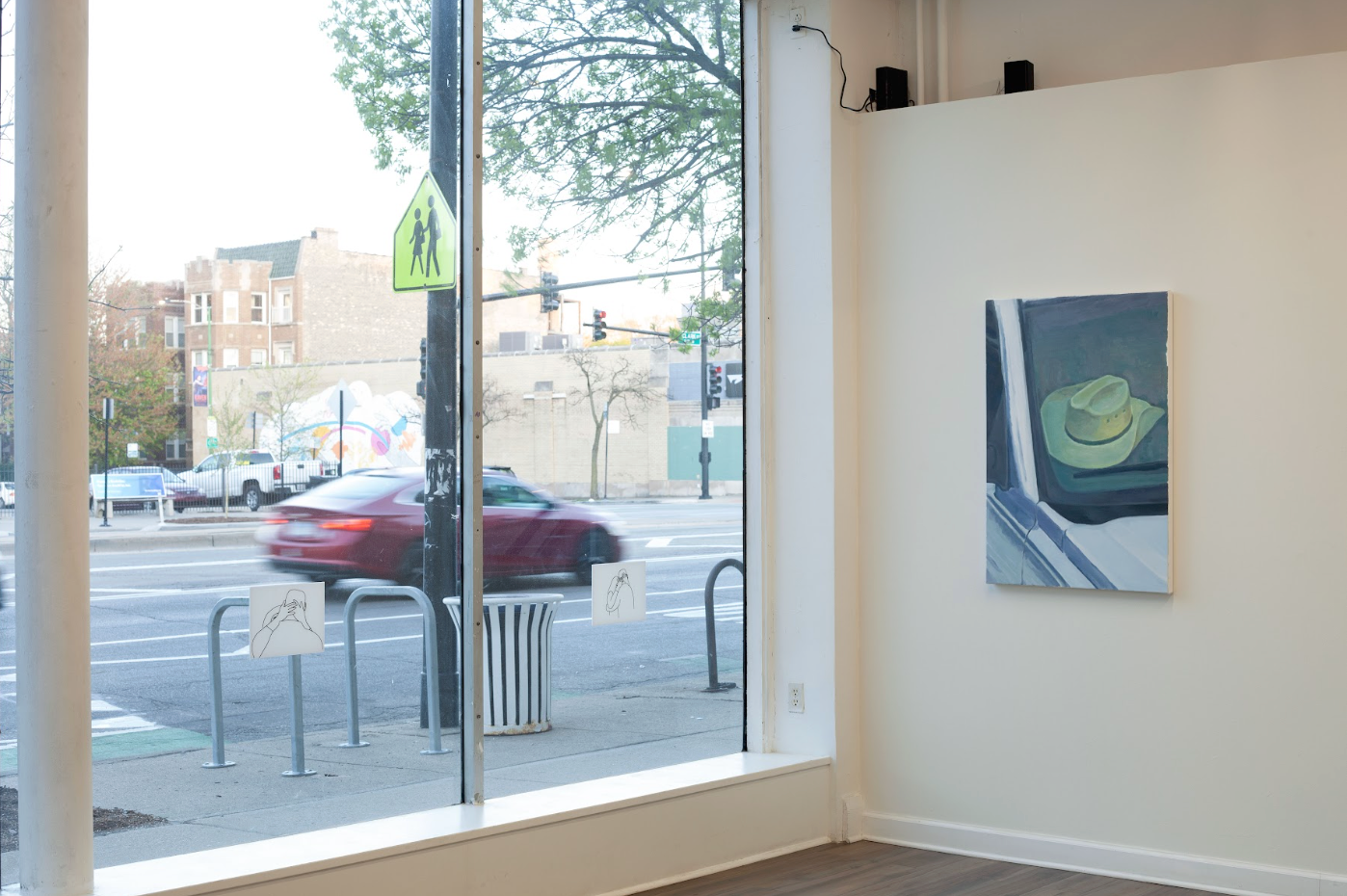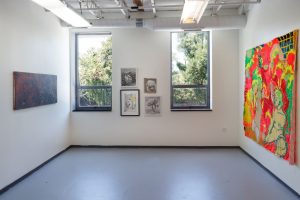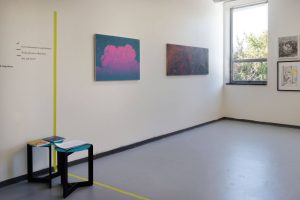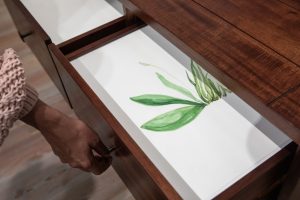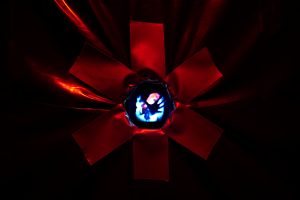
Zespo’s solo painting exhibition ¿Cómo pinta? (How’s it Looking?) opened on April 17, 2025, at Pueblo Unido Gallery (6212 N Clark St. Chicago, IL 60660), a community-driven art space rooted in collective engagement. The gallery is closely connected to Centro Romero, a long-standing community-based organization that has supported refugee and migrant communities on Chicago’s Northeast side.
The new series of paintings in the exhibition centers on Zespo’s renderings on his father’s work as a concert promoter and booking agent who organizes regional Mexican music concerts across the Midwest. As a mediator of interconnected events, the role of an agent brings together different performers and audiences into varied venues, where unpredictable chemical reactions unfold between people, moments, and environments–forming the conceptual thread that ties the series together.
This exhibition and contextual understanding of Pueblo Unido Gallery were enriched through conversations with Isabella Aguilar, an emerging curator and Teen Leadership Coordinator at Centro Romero. Isabella shared that the gallery hosts one exhibition per season—fall, winter, spring, and summer—welcoming a diverse audience from both migrant communities and Chicago’s broader fine arts network. Each opening is catered by local food vendors, often families connected to Centro Romero, fostering economic reciprocity and cultural celebration.
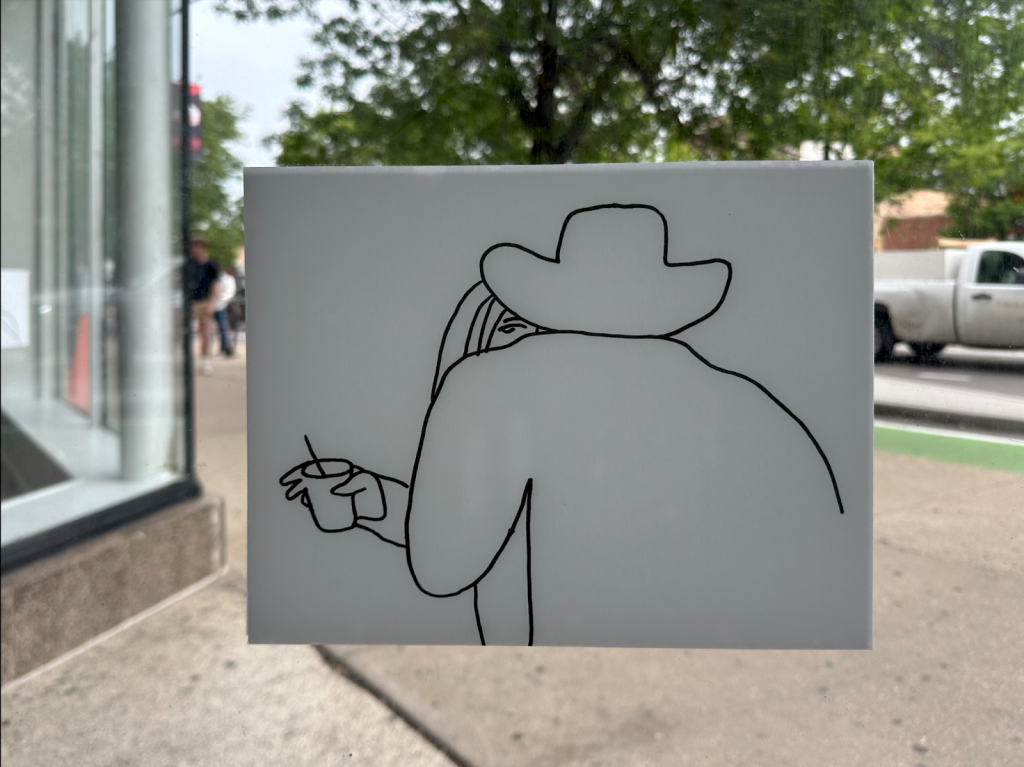
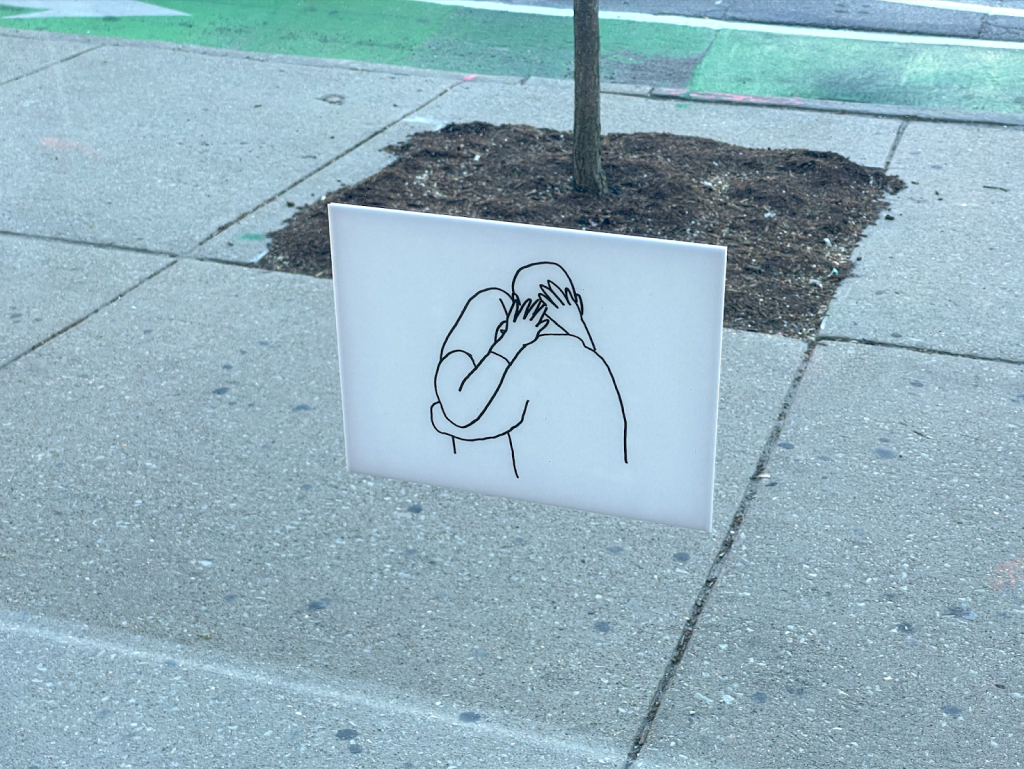
What first welcomes guests in the gallery storefront glass are six sets of Dancing Couples, drawings printed on vinyl. They are mirrored and mounted on both the inside and outside of the glass, roughly at a child’s eye level, intentionally positioned to capture the attention of children passing by after school from the youth program. The drawings depict simplified figures: a man seen from behind and a woman facing him. From the six drawings, one can sense a slow and deliberate evolution in their gestures. The figures seem to move through a sequence of intimate moments. At first, they are simply embracing, then gradually becoming more entwined, as if caught in a tender, wordless negotiation. They kiss, but not abruptly. They seem to be embracing, or perhaps dancing? These small-scale drawings appear to float in midair, revealing different backgrounds when viewed from either side.
“What first welcomes guests in the gallery storefront glass are six sets of Dancing Couples, drawings printed on vinyl. They are mirrored and mounted on both the inside and outside of the glass, roughly at a child’s eye level, intentionally positioned to capture the attention of children passing by after school from the youth program.”
Zespo is gifted with the ability to capture intimate moments and objects that resonate beyond the undertones of music in his artwork. Beginning with instant photographic captures, he transforms these fleeting impressions in the studio through a distinctive visual language: a personal color palette, abstraction, repetition, and framing. What emerges is a generous, visible spectrum of information, ranging from sketch studies to large-scale canvas paintings.
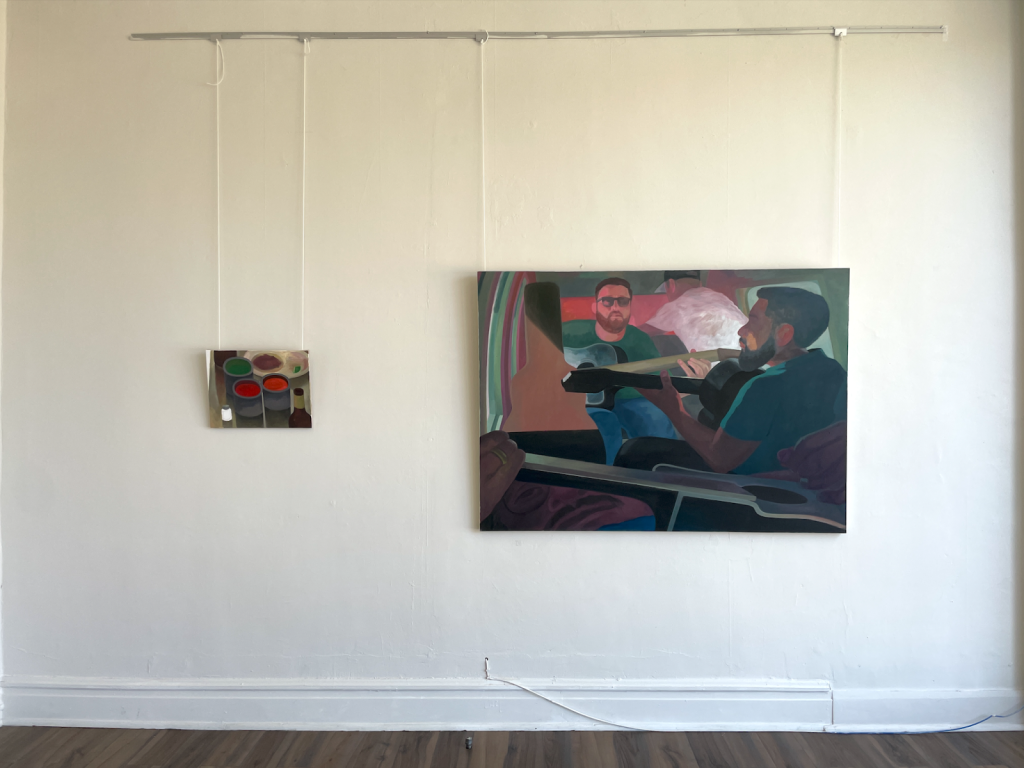
Upon entering the gallery, my attention is immediately drawn to two paintings installed side by side on the right wall: a smaller still-life piece featuring salsa containers titled Red and Green/tu ya no comes chile, and a larger figurative painting titled The Musicians on the Road/Los músicos en el camino. Their juxtaposition sets up a striking contrast in both subject matter and rendering technique. In Red and Green, three vividly colored salsa containers are rendered with a high degree of finish and solidity. The salt shaker’s body retains a penciled contour but is left entirely unpainted, a deliberate omission of color, while only its lid receives the same level of finish as the rest of the painting. This deliberate decision flattens the salt shaker’s presence. It creates a tension between what is rendered and what is merely suggested.
In The Musicians on the Road, this play between detail and flattening reappears in a more complex, figurative register. The three main characters, presumably musicians, are clearly distinguishable and bear a strong compositional resemblance to the salsa trio in the smaller painting. They are direct, intentional, and make sense compositionally. However, the figure closest to the viewer, reclining at the bottom edge of the canvas, appears nearly flattened. Because of the artworks positioning on the wall the viewer’s perspective aligns with the horizon of his lying body, and his face is spatially compressed. Its width nearly matches the shoulder of the next musician behind him. The collapsing depth and intimacy are introduced into a single visual plane.
Pueblo Unido Gallery is also a multi-functional space. Every Saturday from 1–5PM, the gallery is open to the public and staffed by high school students from Centro’s youth program. On weekdays from 3–6PM, it becomes an educational site for academic tutoring and art workshops. Additionally, various departments across Centro Romero, including Adult Education, Legal Services, Public Benefits, the Women’s Program, and the Youth Program, frequently use the space for events and community-driven initiatives.
As I turn to the other side of the gallery, more pairings come into view. They appear innocent at first glance but carry a latent sense of danger. In The Cut/El corte, the butcher’s knife is rendered with stark precision, its blade perfectly straight, evoking a cold, mechanical sharpness. In El siguiente jinete/The living jinete, the figure of a horseman in prayer reaches toward the ground, but the shadow cast by his hand defies anatomical logic. Instead of resembling a human hand, the shadow fractures into a jagged, angular silhouette, implying a long, pointed weapon. These visual cues subtly destabilize the scene, infusing it with an undercurrent of tension and threat.

A similar sense of unease also appears in The Children Playing where children are the main subjects. A little boy and a little girl sit on the ground, fiddling with a box, while adults wearing jeans stand in the background within a scene filled with presumably music. The children’s close physical proximity and the way their bodies lean forward the ground convey a sense of absorbed collaboration in the delight they find within the box before them.
Zespo appears especially adept at revealing the intimate narratives of individual experience that unfold beneath the spectacle of a Mexican regional music concert. These layers of reality do not clash; rather, they coexist in quiet parallel. Even without being displayed directly alongside it, the children’s posture on the ground easily calls to mind the image of the praying horseman. Is there some connection or underlying implication between them? Being close to the ground can suggest reverence or modesty, but it can also signal a safer space for exploration, a stage for play and imagination. The physical separation of the children from the adult in the background becomes a message in itself. The child’s hands are depicted in a loosely defined, imprecise way, which seems to soften the sharpness of the horseman’s hand.
The quiet melancholy that runs through the exhibition finds its most poignant expression in the Al fondo series displayed on the back wall, each piece bearing a more detailed title. From top left to bottom left, then down to the next column and up again—they are: Al fondo (from a distance), Al fondo (around 4pm), Al fondo (in VIP), Al fondo (on the stage), Al fondo (like the flag), Al fondo (in Michigan), Al fondo (in Green Bay), Al fondo (without touching the lips), Al fondo (in seconds), and Al fondo (quietly). Like title cards in an experimental film, each specific phrase—evoking a place, an object, a color—introduces a new and subtle emotional affect to the series of drawings. Beginning in the top left corner, the viewer is placed in the perspective of someone recording with a phone. As the sequence unfolds, each painting offers a new fragment of detail, at times zooming in, at times focusing closely on a particular action. The energetic, assured brushstrokes in this group of works hint at a process that is both rapid and deliberate. At times, the lack of color distinction renders things muddy and indistinct. The quality conveyed by the brushstrokes is reminiscent of the event depicted in the image, where the central action is pouring alcohol in a straight pouring shot. It might take place under the witness and cheering of a crowd, perhaps on a stage at the height of a performance. It may occur as multiple instances unfolding simultaneously. Yet as the series progresses, the depictions increasingly narrow down to a solitary figure left in place, quietly experiencing the act alone. Through a conversation with Zespo, he mentioned that he was “finding a formal strategy to capture that duality,” and that this was a painting problem, one that couldn’t be resolved within a single piece of work. The decision to develop a series emerged from the need, in his words, to “unpack [the problem] further.” We came to a shared understanding that the performative aspect of these events, while visible on the surface, often shifts in the moment, what might initially seem like something you’re expected or pressured to do can become something you genuinely desire to do, shaped by the atmosphere and emotional charge of being there.
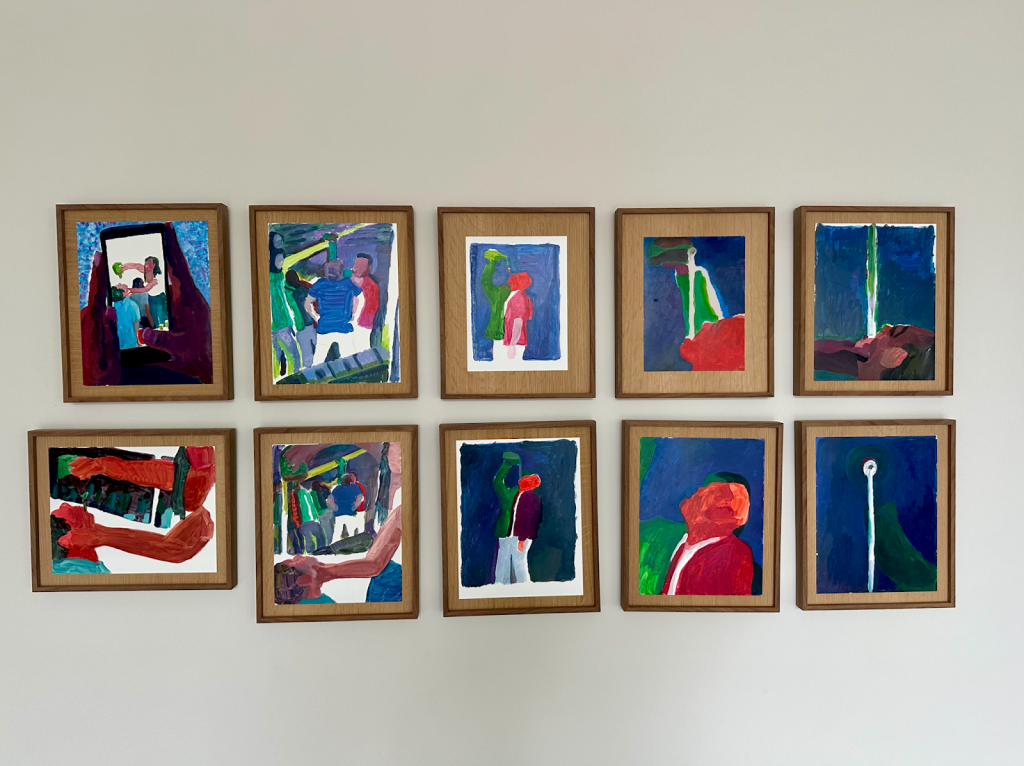
I turned around and saw the painting La parejita of a couple embracing as they danced on a lavender and blue hued dance floor. I was moved by how even their blue shadows dissolve into the colors of the floor. All that remains in the image are the romantic hues and a single pillar that helps orient the viewer’s sense of perspective and space. I thought about Jia Zhangke’s film Mountains May Depart, the opening scene where Shen Tao dances in the ballroom to Pet Shop Boys’ Go West… Sometimes, we don’t need anything else, and there’s nothing that needs to be said. We just need to be the ones who were there.
Zespo’s depiction of the Mexican regional music concert reveals a complex cultural tapestry—one that extends beyond a simple celebration of music. It encompasses rich cultural traditions and the deeply human connections formed through shared experiences: the exchange of food, family bonding, lovers finding each other, and the coexistence of cultural events like bullfighting. This multifaceted reality highlights how music intersects with broader social and cultural practices. The exhibition title ¿Cómo pinta? (Literal translation is: How does it paint? But it means: How’s it Looking?) resists a singular interpretation and does not merely demand a formal act of looking. It evokes an atmosphere that is ambiguous, uncertain, and charged with an undercurrent of tension. The viewer, in a sense, is invited to confront their own idealized notions of concert joy—to let themselves witness and drift into these intimate, personal moments, to imagine, and to momentarily escape.
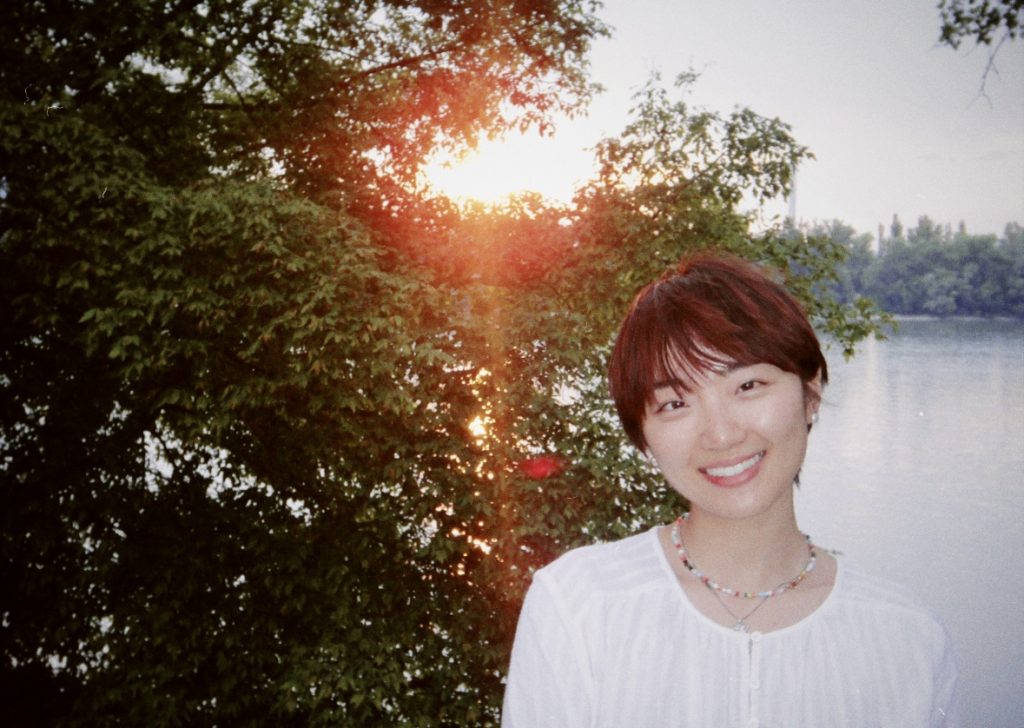
About the Author: Tianjiao Wang is interested in acknowledging the presence of things. She is a practicing artist focusing on photography and film. She was born in Beijing and now lives in Chicago.
